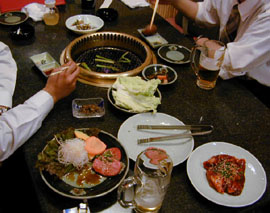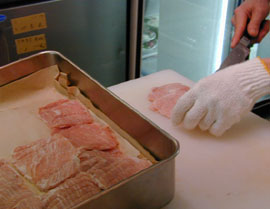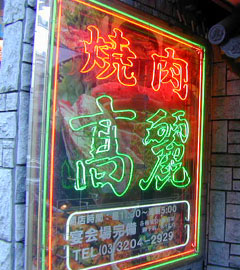Cows Get Mad, Restaurant Owners Get Angry
The newsroom's bonenkai was at the ballroom in the Hotel Yamato. Crisp midweek late December night. Eighteen tables. Waiters in white and black. A full five courses.
 Just after we were served the main dish, the Boss stood at his table and began his end of the year speech:
Just after we were served the main dish, the Boss stood at his table and began his end of the year speech:
First, as a result of Japan's continued recession, I am sorry to say that there will be harsh reductions in this year's winter bonuses...
I whispered to junior reporter Junko, "How's your burger?"
As a consequence, for my own needs, I've started shopping at 100-yen shops for small things like pencils, neckties, and toothbrushes. I recommend you consider similar options...
"It's fine," she said. "Why do you ask?"
Second, we've decided to institute cutbacks at the office. Building and utility maintenance, floor and window cleaning, and trash pickup will be cut...
"The Boss asked me to pick up the tofu patties for tonight's party. I assumed because of cost cuts. But I managed to pull some strings and got a great price on the real thing!"
Newsroom employees will be expected to sharpen their repair and maintenance skills and take over all these duties. Additionally, later this year we might have to cut the elevator...
Junko balled up her napkin, stood, and screamed in my direction: "We are eating real beef???? Are you crazy!!!! ALL BEEF in Japan is cheap now because of mad cow disease!!!!"
One woman in typesetting fainted. Two men from the graphics lab began choking. The Boss dropped his note cards. All heads turned toward our table. Things suddenly got real quiet. I reached for my pack of cigarettes.
On Shokuan Street just north of Tokyo's Kabukicho district is perhaps Tokyo's greatest concentration of yakiniku restaurants. In this predominantly Korean section of the city, customers grill a variety of seasoned beef dishes, accompanied by a number of sauces and vegetables, on personal barbecues in a style whose roots go back to Korea.
 Typically at this time of year, the dozen or so restaurants in this area would be packed each night with revelers washing down their grilled rump and tongue portions with beer and sake at private year-end parties with friends or coworkers. But not now.
Typically at this time of year, the dozen or so restaurants in this area would be packed each night with revelers washing down their grilled rump and tongue portions with beer and sake at private year-end parties with friends or coworkers. But not now.
"Our business is off 40%," grimaces Seung Young Choung, manager of Hangukan. A similar story can be told across the street at Korai by manager Sang Woo Lee. Business at his place has dropped 30%.
The culprit behind the fall at these restaurants can be directly attributed to the discovery of bovine spongiform encephalopathy, or what is referred to as "mad cow disease," in three milk cows. Just over three months ago, the first case of the disease that wastes away the animal's brain (and potentially a human's as well should diseased meat be consumed) was confirmed in Hokkaido. Since then two more milk cows have tested positive and Japan's entire beef and dairy industry has been thrown into a shambles. Further exacerbating the problem is the fact that the source of the disease has yet to be discovered.
But even with the dire state of their business, both these managers feel a bit lucky. Being mainly Korean restaurants, they also feature some special Korean dishes that do not include beef. However, the crisis is taking a much larger bite out of shops that provide strictly yakiniku fare.
Perry Chan, owner of meat distributor Yonechiku Co. in Ichigaya, Tokyo, estimates that on average each of his ten yakiniku customers have lost 60% of their business. Perry thinks that if things don't change soon half of them will be out of business before 2002 ends.
Critics have blamed the action, or rather the lack thereof, by the Agriculture, Forestry and Fisheries Ministry as being a bellows fanning the anti-beef flames across the nation. It wasn't until early October, a full month after the first diagnosis, that meat and bone meal feed was banned in Japan's livestock industry. It was because Japan was using this feed that a report issued by the European Union ten months ago indicated that it was at a high risk to develop the disease. The report was ignored by the Japanese Government.
 As a result, supermarkets, restaurant owners, and beef brokers, however, can't ignore the fact that they are now being hit with increased scrutiny over the outbreak by the media and the public. This is not the case for the livestock industry as a whole though. It is being hit with something else entirely - cash.
As a result, supermarkets, restaurant owners, and beef brokers, however, can't ignore the fact that they are now being hit with increased scrutiny over the outbreak by the media and the public. This is not the case for the livestock industry as a whole though. It is being hit with something else entirely - cash.
In October, the Agriculture Ministry earmarked over 100 billion yen to aid the entire livestock industry in supplementary budgets, subsidies, and disease prevention programs. The ease with which this was passed is as a result of the notoriously cozy ties that the agriculture industry shares with the vote-needing Liberal Democratic Party. This is something that angers Seung Young.
"They provided emergency money to the stockbreeders," he says. "But what about us and the meat retailers? They've [the Ministry] just put on a good face."
Though some of the emergency money has gone to propping up beef prices, the average price for a cow is hovering at just around 30,000 yen. "This is less than the cost of the feed," says Seung Young. "The government should buy all the cows at the original prices of roughly 200,000 yen each to protect the meat retailers. Otherwise, they might be bankrupt today, tomorrow...the next day."
Though neither of the Korean shops have lowered their prices, they both have beefed up on measures to attract customers and reinforce the fact that their beef is safe for consumption.
Sang Woo slightly modified his menu to include more pork dishes. Also, he has posted a sign at the entrance of his 200-seat restaurant and at the register that states that his beef has been properly inspected and meets all standards set forth by the Agriculture Ministry.
 Seung Young's restaurant is about one-quarter the size of Sang Woo's so his approach is a little different. "I have trained my employees to have a positive attitude," he says. "If their attitude towards the safety of the beef is unclear, the customer will not want to eat the yakiniku."
Seung Young's restaurant is about one-quarter the size of Sang Woo's so his approach is a little different. "I have trained my employees to have a positive attitude," he says. "If their attitude towards the safety of the beef is unclear, the customer will not want to eat the yakiniku."
The public's confidence in the safety of Japanese beef is the most important point in resolving the issue, or so says Sang Woo. Government ministers eating beef on TV to show that it is safe, as they did in early October just after the feed ban, is a mere stunt, he says.
He feels the priorities of the government should be in presenting the information in a balanced manner to the media as quickly as possible. Right now, he believes, the media is merely focusing on the lack of trust in the government.
The fact that each of the 1.3 million cows to be used for consumption in Japan in the next year is now being screened in a three-stage process for mad cow disease is being overlooked. "The media is not trying to see things from more than one perspective," he says. "That's why Japanese people don't feel the beef is safe."
The best cure though in easing the public's fears is time, he says. "By May, business will be better."
Hopefully by then he and his competitor across the street won't have already been sent out to pasture.
Note: Junko Nakazawa contributed to this report.

